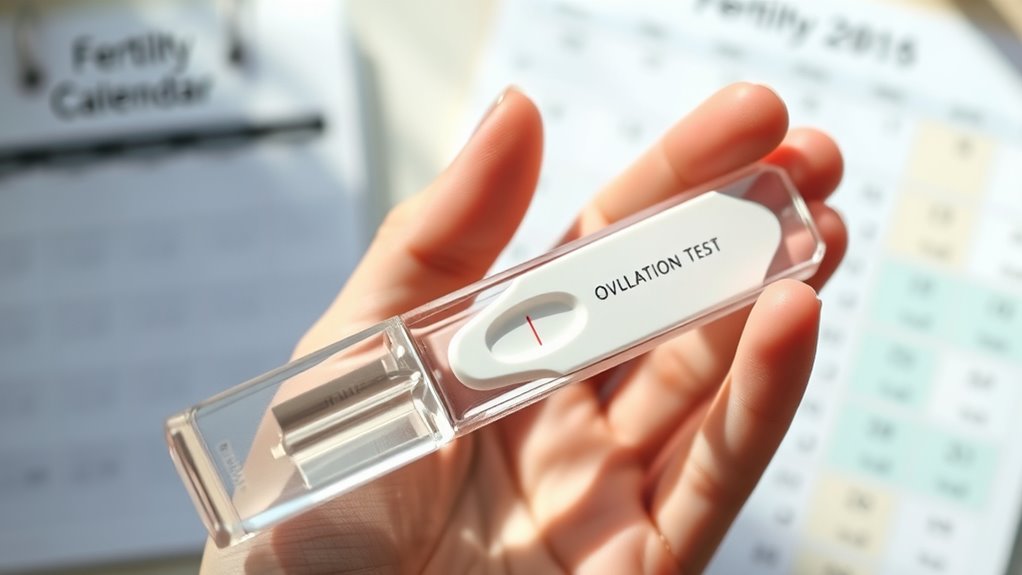Fertility Awareness Method (FAM) is a science-based way to track your menstrual cycle by observing hormonal signs like cervical mucus, basal body temperature, and physical sensations. It helps identify your fertile days, typically around ovulation, so you can plan or prevent pregnancy naturally. Consistent monitoring is essential for accuracy, but understanding your body’s signals gives you valuable insights into your reproductive health. Stay with us to explore how you can master these techniques effectively.
Key Takeaways
- FAM tracks hormonal and physical signs like cervical mucus, basal body temperature, and cervix position to identify fertile days.
- The menstrual cycle is divided into phases—menstrual, follicular, ovulation, and luteal—that influence fertility indicators.
- Accurate prediction of ovulation involves monitoring cycle length, mucus patterns, temperature shifts, and other fertility signs.
- Consistent daily observation and recording of physiological signs improve the effectiveness and reliability of fertility awareness.
- While beneficial for natural family planning and cycle understanding, FAM requires discipline and may be less reliable with irregular cycles.
Understanding the Reproductive Cycle

Understanding the reproductive cycle is essential for effectively using the Fertility Awareness Method. Your cycle typically lasts about 28 days, but it can range from 21 to 35 days. It’s divided into phases: the menstrual phase, the follicular phase, ovulation, and the luteal phase. During the menstrual phase, you experience bleeding as the uterine lining sheds. The follicular phase follows, where your body prepares for ovulation by maturing follicles in your ovaries. Ovulation occurs roughly mid-cycle, releasing an egg. Afterward, the luteal phase prepares your body for pregnancy or signals the start of a new cycle if conception doesn’t happen. Knowing these phases helps you predict fertile days and plan accordingly, making your awareness of your cycle critical for fertility tracking. Additionally, understanding relationships and trust issues can help women better interpret changes in their cycle related to emotional health.
Key Physiological Signs Monitored in FAM
You’ll want to pay attention to hormonal changes that signal your fertility window, which can be tracked through specific body signs. Observing cervical mucus patterns provides clues about your most fertile days. Monitoring these physiological signs helps you understand your cycle better and plan or prevent pregnancy effectively.
Hormonal Changes Signatures
Have you ever wondered how your body signals hormonal shifts throughout your cycle? These changes create specific signatures you can observe daily. For example, your energy levels, mood, and basal body temperature fluctuate with hormonal fluctuations. During the first half of your cycle, rising estrogen levels can boost your energy and mood. After ovulation, progesterone increases, often causing a slight rise in basal body temperature and a sense of calm or fatigue. Recognizing these hormonal signatures helps you identify fertile days accurately. You learn to notice subtle shifts in your physical and emotional state, which serve as reliable indicators of your cycle phases. Tracking these hormonal change signatures empowers you to understand your body better and make informed decisions regarding fertility and contraception. Understanding father-daughter bond can also enhance your emotional awareness and support during this journey.
Cervical Mucus Patterns
Monitoring cervical mucus patterns provides clear physical signs of your fertility status. As your body responds to hormonal shifts, your mucus changes in consistency, color, and amount. When you’re fertile, mucus becomes clear, stretchy, and resembles raw egg whites—signaling your most fertile days. Post-ovulation, it thickens and dries up, indicating less fertility. Recognizing these patterns helps you understand your cycle intuitively and confidently. Additionally, observing mucus changes can be an effective way to track your reproductive health over time.
Calculating Fertile and Infertile Days

How can you determine your most fertile days using the Fertility Awareness Method? First, track your menstrual cycle over several months to identify its length. Your fertile window usually occurs around the midpoint of your cycle, typically about 14 days before your period starts. To estimate your fertile days, subtract 14 days from your total cycle length to find your likely ovulation day. Your fertile window then includes a few days before and after ovulation, since sperm can survive up to five days. For example, if your cycle is 28 days, your fertile days are roughly days 10 to 15. Remember, cycle lengths can vary, so monitoring your signs helps refine these estimates. Calculating your fertile and infertile days enables you to better understand your fertility patterns. Cookies used in tracking and analyzing your cycle data can also help improve the accuracy of your fertility predictions.
Practical Techniques for Tracking Fertility Signals

To effectively track your fertility signals, start by observing your body’s natural indicators daily. Check your basal body temperature each morning before getting out of bed, recording any slight rise that signals ovulation. Examine your cervical mucus for changes—wetness, stretchiness, and clarity increase around ovulation. Feel your cervix gently to note its position and firmness, which varies throughout your cycle. Use a fertility chart or app to log these observations consistently. Additionally, pay attention to any ovulation pain or heightened libido, as these can provide clues. Consistent, attentive tracking helps you identify patterns and increases your awareness of your fertile window. Being mindful of body temperature shifts can enhance your understanding of ovulation timing. By practicing these techniques daily, you’ll develop a clear understanding of your individual fertility signals.
Benefits and Limitations of Fertility Awareness

Fertility awareness offers several benefits, such as empowering you with a deeper understanding of your menstrual cycle and enhancing your ability to plan or prevent pregnancy naturally. It encourages awareness of your body’s signals, helping you identify fertile days more accurately. However, it also has limitations. It requires consistent daily monitoring and discipline, which might be challenging for some. Menstrual irregularities or illnesses can affect the accuracy of fertility signals. Additionally, it’s less reliable for women with irregular cycles or those who are breastfeeding. Here’s a quick comparison:
| Benefits | Limitations |
|---|---|
| Promotes natural family planning | Requires daily commitment |
| Increases cycle awareness | Less effective with irregular cycles |
| No hormonal interventions needed | Less reliable during illness or breastfeeding |
| Can be used for conception or prevention | Accuracy depends on proper technique and consistency |
Integrating FAM With Other FAMily Planning Methods

Integrating fertility awareness methods (FAM) with other family planning options can enhance your overall effectiveness and flexibility. Combining FAM with barrier methods, such as condoms, allows you to use FAM to identify fertile days and avoid or plan pregnancy accordingly. You can also pair FAM with hormonal methods if you want added reassurance or reduce hormone use over time. Some couples use FAM alongside withdrawal or diaphragms to increase reliability. This integration offers personalized control, empowering you to choose methods based on comfort, lifestyle, and reproductive goals. It also provides a backup if your fertility signs are unclear or irregular. Incorporating wall organization systems can help you track fertility signs more effectively by providing clear visual cues and reducing clutter. By combining methods, you create a tailored approach that maximizes effectiveness and aligns with your preferences and needs.
Frequently Asked Questions
How Accurate Is Fertility Awareness Method Compared to Other Birth Control Options?
You’re wondering how accurate fertility awareness is compared to other birth control methods. It can be quite effective if you carefully track your cycle, with typical use success rates around 76-88%. However, it’s less reliable than methods like IUDs or implants, which have over 99% effectiveness. Your success depends on consistent monitoring and understanding your fertility signals, making it essential to be diligent if you choose this natural approach.
Can FAM Be Effectively Used by Women With Irregular Menstrual Cycles?
Wondering if FAM fits your fluctuating cycle? You can absolutely use fertility awareness effectively with irregular periods, but it takes more patience and precision. You’ll track your signs diligently, identify unpredictable patterns, and adapt your methods accordingly. While irregular cycles can challenge consistency, committed monitoring can still help you avoid pregnancy or conceive. With dedication and detail, you can confidently navigate fertility’s fluctuations, making FAM a flexible, functional choice for women with irregular cycles.
What Are Common Challenges Faced When Practicing FAM Consistently?
When practicing FAM consistently, you might face challenges like remembering to track your symptoms daily, especially when busy or stressed. Irregular cycles can make it harder to interpret signs accurately, leading to confusion or frustration. You may also struggle with maintaining motivation over time or feeling uncertain about your fertility status. These hurdles require patience, discipline, and sometimes support to stay committed and confident in your tracking.
How Does Age Affect the Reliability of Fertility Awareness Method?
Did you know that fertility declines sharply after age 35? Age impacts the reliability of fertility awareness methods because hormone levels and cycle regularity can fluctuate, making it harder to accurately identify fertile days. As you get older, your cycles may become irregular, reducing the method’s effectiveness. So, if you’re over 35, you might need additional methods or guidance to maintain reliable fertility tracking.
Is Professional Guidance Necessary to Start Practicing FAM Effectively?
You might wonder if professional guidance is essential when starting fertility awareness methods. While it’s possible to learn on your own with books or online resources, having a healthcare professional’s support can improve accuracy and confidence. They can help you understand your cycle better, troubleshoot issues, and ensure you’re practicing correctly. Ultimately, seeking guidance boosts your chances of success and makes the process more reliable and personalized.
Conclusion
By understanding and tracking your body’s signs, you hold the power to navigate your fertility naturally. FAM isn’t just a method; it’s a journey of awareness, revealing the rhythm of your body’s unique song. Embrace it fully, knowing that every sign is a whisper from within—guiding you through the dance of fertility and infertility. In listening closely, you find your own harmony, turning knowledge into confidence and control.









